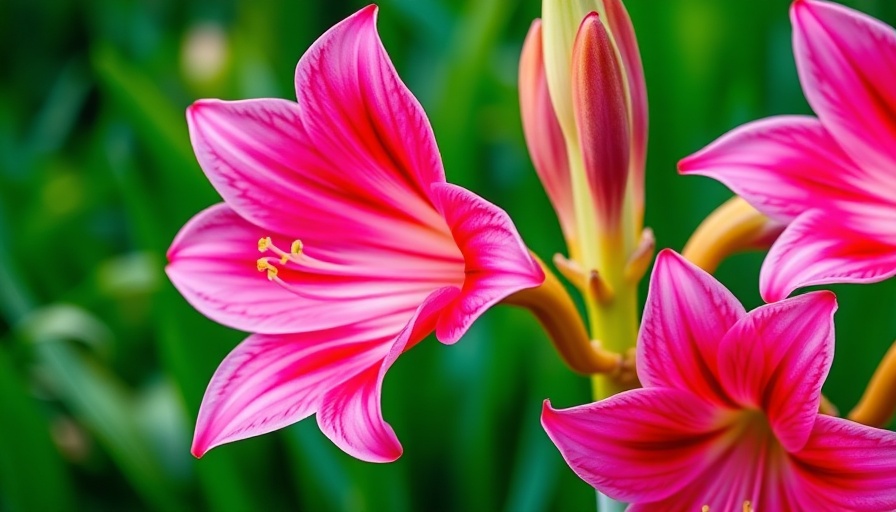
The Alluring Amaryllis Belladonna: A Gardener's Gem
Amaryllis belladonna, commonly known as the Belladonna lily or naked lady lily, is a stunning addition to any garden. This unique flowering bulb graces our landscapes with its striking trumpet-shaped flowers that bloom in late summer and early fall. The captivating hues of burgundy, mauve, pink, and white not only add color but also invite an array of pollinators, including bees and butterflies, making your garden a vibrant habitat.
Growing Conditions and Care for Your Amaryllis
Understanding the right conditions for Amaryllis belladonna is crucial for its thriving growth. These bulbs flourish in USDA Zones 7-11, enjoying full sun and well-draining soil. An interesting aspect of caring for these plants is their dormancy cycle; after blooming, they will enter a resting phase, dying back in spring to prepare for summer dormancy. During this period, providing them with adequate water and nutrients when they’re active will set them up for a strong seasonal comeback.
Container Gardening: Enjoying Amaryllis in Cooler Climates
For gardening enthusiasts in cooler climates or those who wish to indulge in container gardening, Amaryllis belladonna is a versatile choice. By planting them in pots, you can easily move them indoors as needed, especially during frosty months. Consider insulating your containers or bringing them inside to protect these beauties from harsher weather. Not only does this allow flexibility in your gardening, but it also means you can enjoy these florals in a more controlled environment.
Maintenance: Ensuring Lush Foliage
After their breathtaking bloom, Amaryllis belladonna doesn't just fade away; it develops stunning rosettes of long, glossy foliage. Caring for this foliage means providing the right nutrients and maintaining moisture levels. Knowing the right balance will help sustain the plants through their active growth periods, thus enhancing their overall health for the following bloom season.
Common Pests and Diseases to Watch For
No garden is free from pests! Amaryllis belladonna can fall prey to common garden pests such as aphids and spider mites. Regular inspections and maintaining cleanliness in your garden can mitigate these threats. Additionally, learning how to manage diseases and pests effectively paves the way for a flourishing flower garden. For organic pest control, consider introducing beneficial insects or setting up homemade traps using natural ingredients.
The Joy of Sharing: Propagation Techniques for Amaryllis
One delightful aspect of gardening is sharing the beauty of your plants with friends and family. Propagating Amaryllis belladonna is quite easy and can be done through division. When you notice clumps forming, it’s a sign that your bulbs are ready for some division. This not only helps your plants stay healthy but also allows you to expand your enchanting collection of flowers. Just ensure that you’re patient, as this is a gradual process that requires time and care.
Creating a Pollinator-Friendly Garden
As we make strides in environmental awareness, it’s important we consider the habitats we create. The fragrant blooms of Amaryllis belladonna are a natural magnet for pollinators. By including them in your garden design, you are not just beautifying your space but also contributing to the ecosystem. Incorporate flowering plants that bloom at different times to ensure a steady food source for bees, butterflies, and hummingbirds throughout the seasons.
Incorporating Amaryllis in Garden Design
Imagine your landscape filled with colorful Amaryllis belladonna among other garden plants—what a spectacular sight! These perennial flowers can serve as striking focal points in your garden design. Plant them in clusters or use them to line pathways for added charm. Their late-blooming nature brings life to gardens as other plants start to fade, ensuring that your outdoor spaces remain dynamic and attractive throughout the year.
Conclusion: Cultivating a Relationship with Your Plants
Caring for Amaryllis belladonna is more than just a gardening task; it’s about building a relationship with nature and creating a thriving environment where beauty and biodiversity flourish. Take the time to learn about your plants’ needs, share them with others, and watch your efforts blossom into a stunning floral display each season.
 Add Row
Add Row  Add
Add 




Write A Comment